
Janus Henderson: BBB debt — it’s complicated
Nicholas Ware, Portfolio Manager within the Strategic Fixed Income team, discusses the unusually rapid growth of the BBB market for bonds and the implications for the high yield market given where we are in the economic cycle.
11.03.2019 | 10:22 Uhr
There has been an explosive growth in BBB rated debt — bond issues just one notch above high yield — in this economic cycle, driven by the cheap cost of funding and aided by quantitative easing measures. This has been highlighted by numerous people in the market, with warnings that it is unsustainable as the quantum of corporate debt is large; and in particular that of the lowest investment grade debt (rated BBB), which is now US$2.8 trillion in size in the US. Chart 1 shows how BBBs now represent just over half of all outstanding US$ denominated investment grade corporate bonds, and chart 2 shows the growth in these bonds, which has overtaken the combined volume of high yield and leveraged loans in the last few years.
Chart 1: BBBs are the biggest portion of the investment grade index
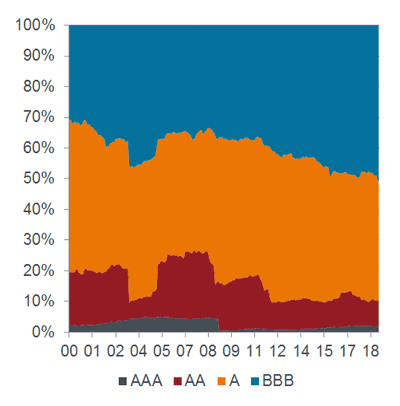
Source: Barclays Research, Factset, Bloomberg, CapIQ, Janus Henderson Investors, as at 31 December 2018
Chart 2: BBB volumes now outpace high yield and leveraged loans combined
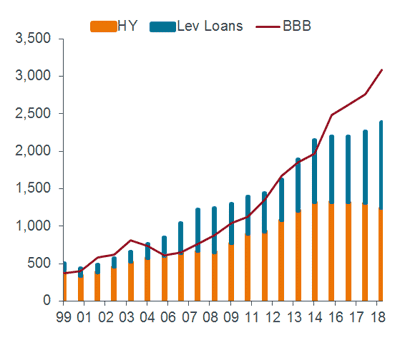
Source: Barclays Live, Bloomberg, S&P LCD, Janus Henderson Investors, as at 31 December 2018
The debt diet
So, why did companies increase leverage and why were the rating agencies so lenient?
Companies have used debt markets for merger and acquisition (M&A) activities, share buy-backs and also to fund dividends, making a conscious decision to lever up given the cheap funding costs.
Additionally, rating agencies have been particularly generous, as the leverage on a number of companies does not resemble what we consider to be investment grade (net debt/EBITDA of less than 3x) and actually look more like high yield. The rating agencies have seemingly drawn comfort from verbal commitments; that companies want to remain investment grade and that they are committed to bringing leverage down over a number of years to levels more suitable for the rating.
Another reason why leverage is rising is that some companies are in structural/secular decline and have seen leverage rise as their financial situation worsened. These companies are, in effect, not in control of their leverage trajectory. This, to our mind, is a much more dangerous issue.
Fallen angels’ potential to disrupt
We have been watching this trend for some time now and for a number of years it did not matter much. The economic cycle was in its growth phase and people believed that companies could grow into their capital structure; ie, grow profitability to reduce leverage ratios.
However, it matters more now as we near the end of the cycle. Debt burdens need to be serviced and leverage brought down, which may prove to be difficult as the economy weakens. It matters to investors too if companies move from investment grade to high yield (rated BBB- or better to BB+ or worse) — what is known as becoming a ‘fallen angel’.
For example, the high yield market in the US is c.$1.2trn in size. If a large investment grade corporate were to be downgraded, its size could overwhelm that market, leading to disorderly moves in credit spreads (the difference in the yield of corporate bonds over equivalent government bonds, in effect, the extra premium needed to hold riskier bonds). This is because a number of high yield funds can hold no more than 2% per issuer in the index in their portfolios, and are thus constrained by how much they could hold.
Further, where the market fears a downgrade for an investment grade issuer, its debt will start trading wider as people anticipate the move into high yield. This impacts the company’s cost of funding and the ability to fund itself, which matters to both credit and equity investors. Forced selling by funds that focus on investment grade will also exacerbate the problem.
We are aware of this risk, given that holding a fallen angel (transitioning to high yield) can lead to price falls. From 2003-16, the average price performance of fallen angels was -10% in the three months leading up to the event. Chart 3 depicts this average price performance for each year over that period.
Chart 3: performance negative ahead of downgrade
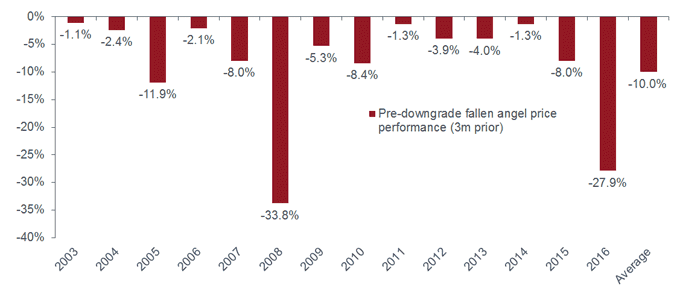
Source: Credit Suisse, Janus Henderson Investors, 31 December 2003 to 31 December 2016. Past performance is not a guide to future performance.
Likely candidates to be ‘disruptive’ fallen angels
In order to determine the possibility of disruptive fallen angels moving into the high yield market, table 1 shows the key fundamental metrics of some of the larger investment grade issuers rated BBB, which are greater than 2% of the high yield market.
Table 1: key fundamental metrics for the likely candidates
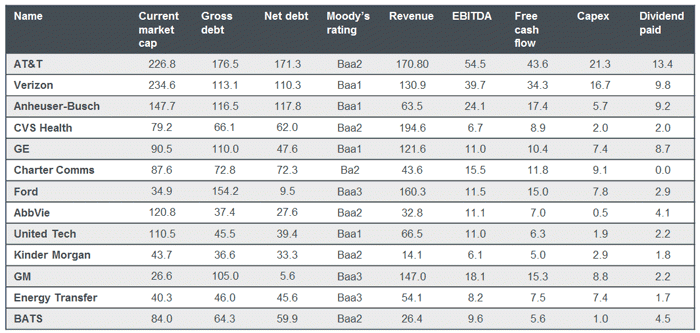
Source:Janus Henderson Investors, as at 19 February 2019
Note: All figures are in US$ billions
There are 13 companies that can be classified as potential disruptive fallen angels. However, many have levers, which can be pulled to manage leverage. These include:
- Cutting dividends
A number of companies consider this to be sacrosanct and take great pride in increasing dividends. However, Anheuser-Busch InBev, in conjunction with its Q3 2018 earnings results, announced a 50% reduction in its dividend. We think more will follow this route. - Asset sales
Both AT&T and General Electric (GE) have recently announced plans to sell assets to help meet their leverage targets. Again, this is a sensible course of action but if the economy turns for the worst this possibility diminishes, as private equity and corporate willingness to pay the price that the seller is looking for reduces. - Reduce capital/operational spending
Cutting capital and operational expenditure is another way to generate cash flow to delever (reduce debt) but this is possibly at the expense of future growth. - Refinancing near-term maturities
Recently AT&T announced a new US$5 billion deal to refinance some of its 2021 maturities. This follows similar actions by firms such as Anheuser-Busch InBev and Verizon in recent weeks, all of which have used tenders or exchanges to term out (extend) maturities over the next few years (in some cases, through 2026).
Getting religion
We have summarised what we view as the prospects for these larger issuers in chart 4. In our minds they can be split into two distinct sects: those who can ‘self help’ and pull themselves out of the quagmire; and those who are helpless to their prospects. The latter group have cyclical and structural problems and are thus in what we call ‘structural decline’* — of which Ford is arguably the worst.
The first group must embrace deleveraging religiously to avoid a downgrade, while as mentioned earlier the trajectory of leverage for the second group is most likely out of their hands, making the downgrade almost inevitable.
Chart 4: ability to maintain investment grade rating?
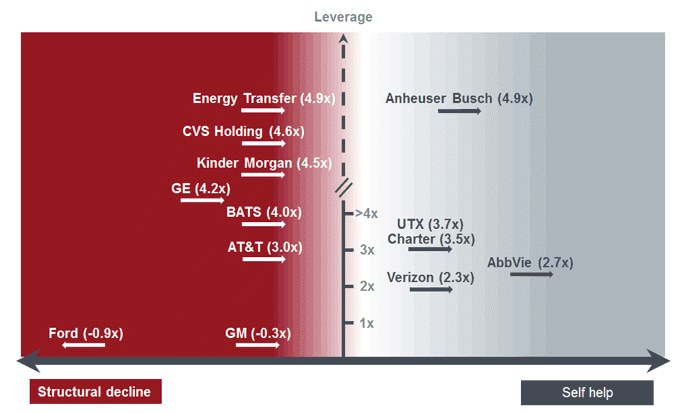
Source: Janus Henderson Investors, as at 01 March 2019
Based on our analysis, there is a strong possibility that Ford could be downgraded to high yield. The market has also started factoring in the possibility, as the price on the Ford 4.346% 2026 bonds has fallen by around 8 points (one point = 1% of 100 par value) since the middle of July 2018. The company has been a high yield business in the past (2005-12), so it does have a track record of operating at that rating level.
Ford’s main credit challenge is improving the performance of its businesses outside of North America and this has weakened its credit metrics. We believe the issue is for the finance company at Ford, who may have to shift to more secured financing (such as asset-backed securities) and away from unsecured bond financing, to keep access and favourable pricing for its customers.
Playing the cycles
Looking at chart 5, it is clear is that BBBs are higher beta (more volatile) than other credit rating categories, but equally, once the market recovers, they tend to outperform.
However, in the current climate we are wary of BBBs and believe that they represent a greater risk than their yields might suggest and much prefer to be invested either side in single A and double B rated issuers that historically have presented a steadier profile, relatively speaking. It is of course all down to stock selection; separating the self help entities from the rest. In addition, exploring BBB strategies makes sense when the cycle turns but should be done selectively at the end of the cycle.
Chart 5: BBBs are higher beta
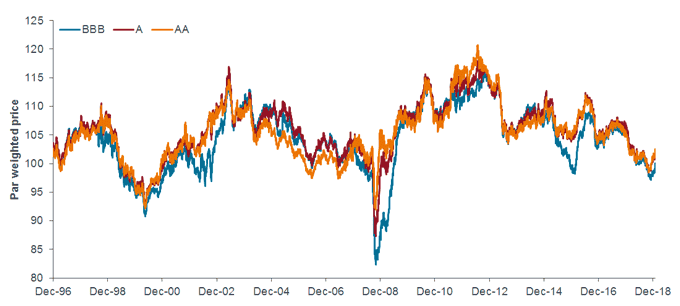
Source: ICE BoAML, Bloomberg, Janus Henderson Investors, as at 31 January 2019
Note: Par weighted price for BBB, AA and A US Non Financial Corporate indices. Past performance is not a guide to future performance.
Final thoughts
Our more optimistic view is that many of the larger issuers have levers, which they can pull to protect their credit ratings. However, there is scope for accidents. If the economy slows, it may delay the prospects for de-leveraging, endangering the companies’ ratings. A general rule of thumb, which we follow and which helps us identify problems further down the line, is to follow the debt growth.
Very simply, the explosive growth of BBBs is one of the excesses of the cycle and will be one of the problem areas when the economy turns down. Thus, this is an area of the markets where we will be cautious and selective.
*Structural decline: when changes in society such as changing demographics, consumer behaviour, low-growth economics and technology-driven disruption act against a business model




Diesen Beitrag teilen: